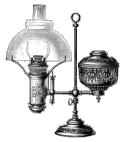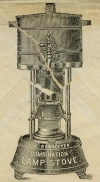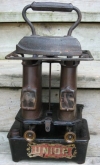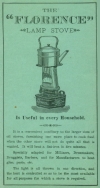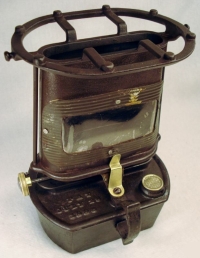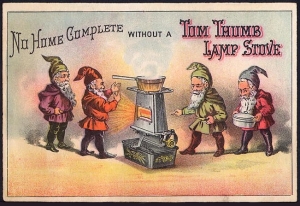it's a lamp...it's a stove
The lamp-stove was an appliance which had multiple uses: it functioned as a stove, a heater, and a lamp. Lamp-stoves came in a variety of sizes from one to three burners. The single burner models were quite portable and were often fitted with a finger hold for carrying like a hand lamp or lantern. As a stove, these items found a niche as a small and portable method of cooking or heating items such as irons. Advertising claims stated that they could boil water in 8 minutes and heat a flat-iron in 5 minutes. They were economical in that they heated up quickly and were a lower-cost option to stoking up the wood or coal stove. They were sturdier than similar devices that were invented to be used on top of a regular lamp chimney which was prone to breakage and often proved unstable.
For illumination, the lamp-stoves were most often fitted with mica "windows." This allowed the light from the wide wicks to be cast outward like that of a lantern or head lamp. The mica window also allowed the user to view the height of the flame and adjust same as needed. These mica pieces were often held in place by a removable frame so the mica could be removed for cleaning if it became dirty or sooted, or replaced if it became damaged. Companies that were know for making lamps often made and sold a line lamp-stoves and heaters. The Rochester lamp-stove depicted at the top of the left-hand margin was one such device. These were often fitted with the #10 or mammoth founts they used in their store lamps. In some cases, the enclosure was partially cut away to allow the unit to function as a lamp as well. Others which were designed more as heaters, such as the Banner Oil Heater, were often surrounded by pierced tin or steel and provided little useful light. The Perfection heaters that were very common around the turn of the century and well into the 20th century were offered with a full cylinder of glass as shown here.
The IRON CLAD LAMP STOVE depicted above was manufactured by the Monitor Oil Stove Company of Cleveland, Ohio. They also had offices in Boston. This stove uses the burner shown here. This burner is embossed "PAT FEB 8, 87 - No. 347,545." This patent was granted to Lewis J. Atwood and assigned to The Plume & Atwood Manufacturing Company. It is not known if Plume & Atwood provided the burners for them. The Florence Machine Company of Florence, Massachusetts manufactured sewing machines and a full line of lamp-stoves and larger oil stoves. According to their advertising pamphlet, they started offering them around 1876. These items remained popular well after the turn of the century as they are often mentioned in magazine advertisements in the early 1900's. Dexter W. Goodell and Oscar N. Kyle obtained a patent for a lamp stove on June 8, 1886. Their patent number 343,535 was assigned to The Florence Machine Co. and conforms substantially to the Florence Lamp Stoves seen in their advertisements. A.W. Shumway assigned his invention to the company for a portable tin oven for oil or gas stoves - pat. no. 383,830 in 1888. Other patents assigned to The Florence Machine Co. include number 204,557 on June 4, 1878 and design patent no. 13,071 on July 25, 1882. On November 15, 1890, the Central Oilgas Stove Company was incorporated and absorbed the Monitor Oil Stove Company, the Florence Machine Company, and several other stove manufactories.  Patent Search Interface Patent Search InterfaceTo view any of the patents referenced in this article, enter the patent number in the field below and click Query USPTO Database. This will open in a new window and take you to the U.S. Patent & Trademark Office Database - directly to the patent in question. Learn more about the USPTO here.
|
